
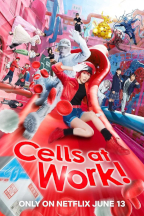
Hataraku Saibou
Japan 2024
Genre:
Action, Drama, Comedy
Director:
Hideki Takeuchi
Cast:
Mei Nagano
Takeru Satoh
Mana Ashida
Sadawo Abe
Koji Yamamoto
Riisa Naka
Wakana Matsumoto
Shota Sometani
Fukase

Cells at Work

Story: Niko Urushizaki (Mana Ashida) is a teenager, and since the death of her mother she also has to take care of her father Shigeru (Sadawo Abe), who works all the time, but drinks too much alcohol, smokes cigarettes and eats fast food. She constantly scolds him because of his bad blood levels. Niko herself wants to study medicine and takes a lot of care of her body. However, the red blood cell AE3803 (Mei Nagano) is still not able to find its way around her body. She also thinks it is unfair that her only job is to transport oxygen, while the white blood cell U-1146 (Takeru Satoh) eliminates foreign bodies in form of viruses or bacteria like a superhero. The two blood cells constantly meet when a cold or a graze has to be kept at bay. The white blood cell eventually manages to convince the red one that they are all playing in a team and that their individual tasks are all very important. In the meantime, everything is going great for Niko, she even has a date with the boy she has liked for a long time. But inside her body, one of the growing white blood cells mutates and starts to attack the other cells. More and more malignant cells appear until Niko faints and has to be brought to the hospital. There the doctors diagnose her with leukemia. Now U-1146 and his friends, as well as the killer T cells, have to do everything they can to eliminate the enemy. But that doesnít turn out to be so easy ...




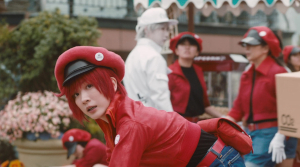
Review: I didnít really have much interest in "Cells at Work", as the trailer looked like a light-hearted way of trying to explain to children how the human body works on a cellular level, while the cells themselves kind of reminded me of the "Power Rangers" because of their garishly colored costumes. But that doesn't do this manga adaptation justice at all. There is an amazing number of things happening and itís not just the action that manages to surprise you in a positive way, the drama that unfolds in the course of the story is quite pleasing too. It's particularly fascinating that in addition to the story about cells, we actually also get a frame story about a father and his daughter. Something that is not a given, because with that the adaptation deviates massively from the original, in which we learn nothing about the actual people in whom the cells do their work. As it turns out, it was a good decision to change that, because the cells themselves are not human enough, and without the frame story, the movie would have felt rather distant and hardly accessible.
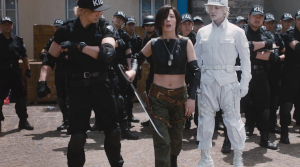
The processes within the human body are repeatedly visualized in an easy-to-understand way. Each cell has a specific costume with a dominant color and performs a very specific task. Takeru Satoh plays the white blood cell that only knows how to fight as he protects the body from everything that doesn't belong there. Keeping to this role, he stays rather flat as a character and hardly manages to generate any interest on his own. Only through his interactions with the red blood cell does he get some rough edges. But it is thanks to Mei Nagano that we are actually interested in the processes within the body. She is the red blood cell that still tries to find its role. Always disoriented and somewhat overwhelmed by her tasks, she wanders through the body until she finally finds her place and completely gets in the zone. She shows the necessary charisma so that later on the storyline on the cellular level can even work from a dramatic perspective.
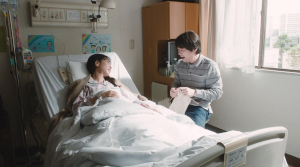
The "society" portrayed in the body follows the rules of collectivism. Every cell has its task and if it does not fulfill it, its time has come to be eliminated from the body. Which is only understandable, otherwise the body would get sick. The "villain" of the story is a faulty cell that refuses to die because of it. Strictly speaking, cancer is nothing more than cells that refuse to die. This also turns the villain into a tragic figure and very quietly raises a question that is avoided in the manga by Akane Shimizu: Is the body actually just a dystopian society at a cellular level? Work and be happy at work. If you act individualistically, you will be sorted out as a foreign body in this society. It would have been nice if "Cells at Work" had dealt with this a little more instead of just cautiously hinting at it. But it's also obvious that the movie has already taken on quite a lot. After all, there is also the frame story.
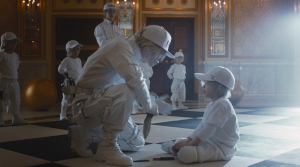
In it, Niko, played by Mana Ashida ("Confessions"), is in the foreground, she is the quasi-adult in the family and has to take on the role of the mother for her father. While she leads a healthy life, her father only cares about having as much fun as possible, which includes consuming alcohol, tobacco, and fast food. So, it's no wonder that his body represents a visual counterpart to the colorful and cheerful cellular world of the daughter. However, it is her body of all places that unfairly has to face a major catastrophe as cancer strikes. Switching between the processes in her body and the drama that unfolds in her life is successfully implemented and increases both the suspense level and the viewerís emotional involvement. Sadawo Abe ("Parasyte") as the father, who was previously irresponsible and playful, is now forced to be there for his daughter, and he does so with all his heart. Him showing his adult side without losing his silly nature, thanks to which he can also provide emotional support for his daughter, gives the movie the aforementioned level of humanity, which would have been impossible in a story that only revolved around the cells.

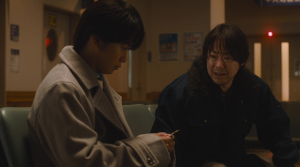
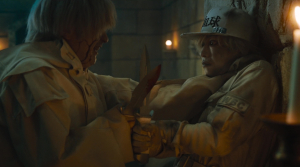

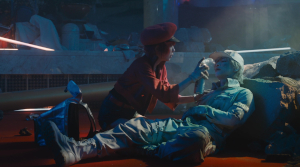
"Cells at Work" can be surprisingly dark. Which is also a small point of criticism, because the first half stands out with a carefree atmosphere and some funny moments - for example, when the father is stuck in traffic but desperately has to go to the toilet, so that the sphincter muscle in his body has to fight an unpleasant battle. It's also impressive how many extras were used for the cells, and the colorful sets, including a fairytale castle depicting bone marrow, are quite inspiring too. The fights are also more dynamic than you might expect. Apparently, Takeru Satoh was "Rurouni Kenshin" for far too long, as his altercations look like he is still the Manslayer. But thatís nothing to complain about, because he simply glides and cuts his way through the evil cells making it a lot of fun to watch. In addition, a few gigantic weapons or over-the-top costumes underline this feeling of carefree fun. Until it gets quite dark and dramatic towards the end. If you donít mind this tonal change, you will find an amazingly captivating and entertaining manga adaptation here.

Disclaimer










